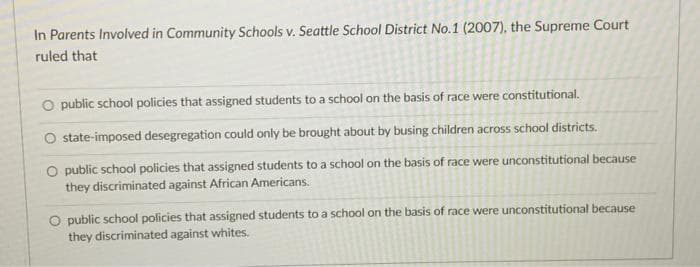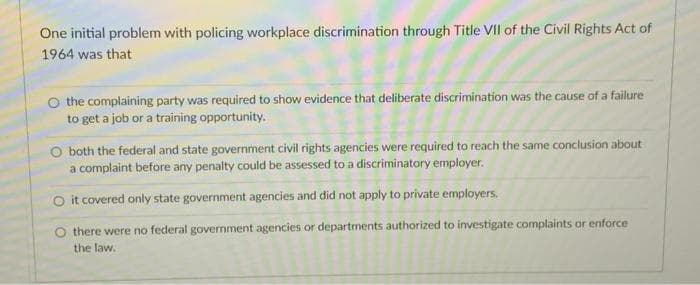In Parents Involved in Community Schools v. Seattle Sehöol ruled that O public school policies that assigned students to a school on the basis of race were constitutional.
In Parents Involved in Community Schools v. Seattle Sehöol ruled that O public school policies that assigned students to a school on the basis of race were constitutional.
Managerial Economics: A Problem Solving Approach
5th Edition
ISBN:9781337106665
Author:Luke M. Froeb, Brian T. McCann, Michael R. Ward, Mike Shor
Publisher:Luke M. Froeb, Brian T. McCann, Michael R. Ward, Mike Shor
Chapter16: Bargaining
Section: Chapter Questions
Problem 16.4IP
Related questions
Question
Ans both.. otherwise dont ans

Transcribed Image Text:In Parents Involved in Community Schools v. Seattle School District No.1 (2007), the Supreme Court
ruled that
O public school policies that assigned students to a school on the basis of race were constitutional.
O state-imposed desegregation could only be brought about by busing children across school districts.
O public school policies that assigned students to a school on the basis of race were unconstitutional because
they discriminated against African Americans.
O public school policies that assigned students to a school on the basis of race were unconstitutional because
they discriminated against whites.

Transcribed Image Text:One initial problem with policing workplace discrimination through Title VII of the Civil Rights Act of
1964 was that
O the complaining party was required to show evidence that deliberate discrimination was the cause of a failure
to get a job or a training opportunity.
both the federal and state government civil rights agencies were required to reach the same conclusion about
a complaint before any penalty could be assessed to a discriminatory employer.
O it covered only state government agencies and did not apply to private employers.
there were no federal government agencies or departments authorized to investigate complaints or enforce
the law.
Expert Solution
This question has been solved!
Explore an expertly crafted, step-by-step solution for a thorough understanding of key concepts.
This is a popular solution!
Trending now
This is a popular solution!
Step by step
Solved in 2 steps

Recommended textbooks for you

Managerial Economics: A Problem Solving Approach
Economics
ISBN:
9781337106665
Author:
Luke M. Froeb, Brian T. McCann, Michael R. Ward, Mike Shor
Publisher:
Cengage Learning


Principles of Economics 2e
Economics
ISBN:
9781947172364
Author:
Steven A. Greenlaw; David Shapiro
Publisher:
OpenStax

Managerial Economics: A Problem Solving Approach
Economics
ISBN:
9781337106665
Author:
Luke M. Froeb, Brian T. McCann, Michael R. Ward, Mike Shor
Publisher:
Cengage Learning


Principles of Economics 2e
Economics
ISBN:
9781947172364
Author:
Steven A. Greenlaw; David Shapiro
Publisher:
OpenStax



Economics (MindTap Course List)
Economics
ISBN:
9781337617383
Author:
Roger A. Arnold
Publisher:
Cengage Learning